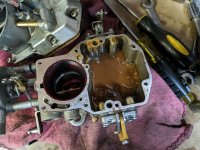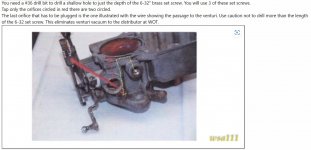This is my first time dealing with an Autolite 1100 and the spark advance system on an old Ford, so bear with me. I've replaced my stock distributor with an HEI unit. When I made the change, I plugged the vacuum advance port on the carburetor and spliced the vacuum advance unit on the HEI to the PCV line using a 3-way barbed fitting. Since I've been doing some additional work before putting the car on the road, it's only been started a few times since these changes were made and seems to run fine.
My understanding from another thread was that the spark advance on the Autolite shouldn't be used with the new distributor. I want to verify that is accurate and ask if there is a better alternative for providing vacuum to the distributor as an alternative to the PCV line. The carb spacer that I'm using has one port and I'm using that for the PCV line. I could drill a second hole and install a fitting for the vacuum advance to the distributor if required.
My understanding from another thread was that the spark advance on the Autolite shouldn't be used with the new distributor. I want to verify that is accurate and ask if there is a better alternative for providing vacuum to the distributor as an alternative to the PCV line. The carb spacer that I'm using has one port and I'm using that for the PCV line. I could drill a second hole and install a fitting for the vacuum advance to the distributor if required.




